Small overlap front: driver-side
Rating applies to 2013-19 models
Tested vehicle: 2014 Ford Explorer XLT 4-door 4wd
The Ford Explorer was redesigned for the 2011 model year. Beginning with 2013 models, the seat belts and airbags were modified.
| Evaluation criteria | Rating |
|---|---|
| Structure and safety cage | |
| Driver injury measures | |
| Head/neck | |
| Chest | |
| Hip/thigh | |
| Lower leg/foot | |
|
Driver restraints and dummy kinematics
The dummy’s head barely contacted the frontal airbag before sliding off the left side as the steering column moved 17 cm to the right, leaving the head vulnerable to contact with forward structure and allowing little airbag cushioning for the chest. The side curtain airbag deployed and has sufficient forward coverage to protect the head from contact with side structure and outside objects. The side torso airbag also deployed. | |
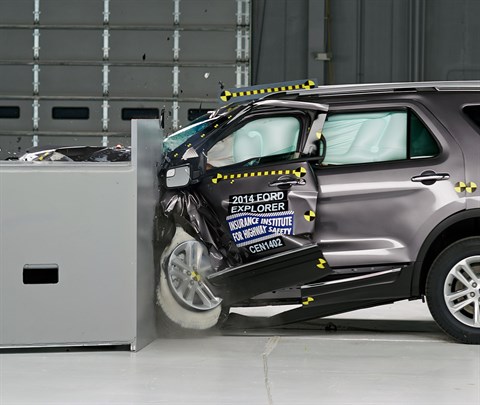
Action shot taken during the driver-side small overlap frontal crash test.
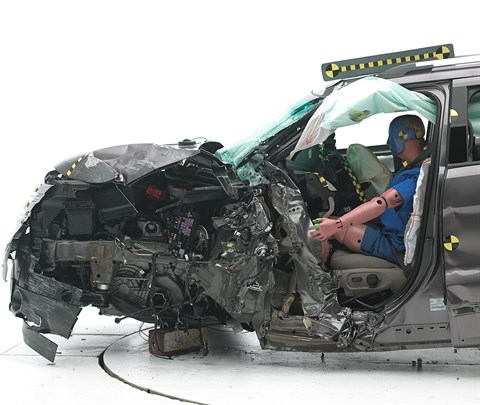
The dummy's position in relation to the door frame, steering wheel, and instrument panel after the crash test indicates that the driver's survival space was not maintained well.
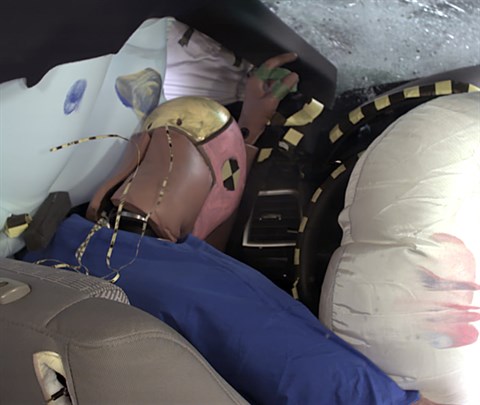
During the crash, the dummy's head and torso barely contacted the airbag before sliding off to the left as the steering column moved to the right.
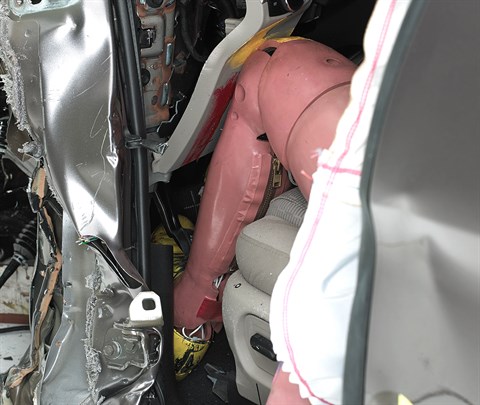
Door hinge pillar and instrument panel intrusion was extensive and contributed to a moderate risk of injuries to the left knee and lower leg.
Small overlap front: passenger-side
Rating applies to 2013-19 models
Tested vehicle: 2018 Ford Explorer XLT 4-door 4wd
The Ford Explorer was redesigned for the 2011 model year. Beginning with 2013 models, the seat belts and frontal airbags were modified, and a knee airbag for the front passenger was added.
| Evaluation criteria | Rating |
|---|---|
| Overall evaluation | |
| Structure and safety cage | |
| Passenger injury measures | |
| Head/neck | |
| Chest | |
| Hip/thigh | |
| Lower leg/foot | |
|
Passenger restraints and dummy kinematics
The dummy’s head contacted the frontal airbag but began to roll toward the right side, leaving the head vulnerable to contact with forward structure. The side curtain airbag deployed and has sufficient forward coverage to protect the head from contact with side structure and outside objects. The side torso airbag also deployed. | |
| Driver injury measures | |
| Head/neck | |
| Chest | |
| Hip/thigh | |
| Lower leg/foot | |
| Driver restraints and dummy kinematics | |
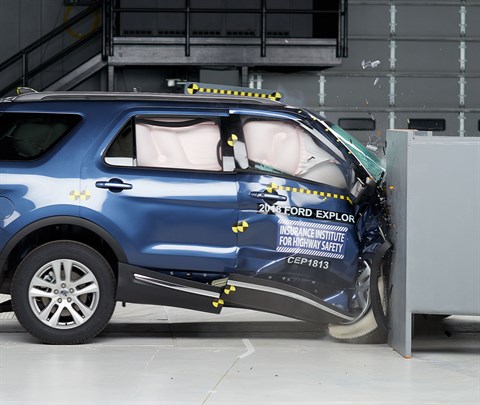
Action shot taken during the passenger-side small overlap frontal crash test.
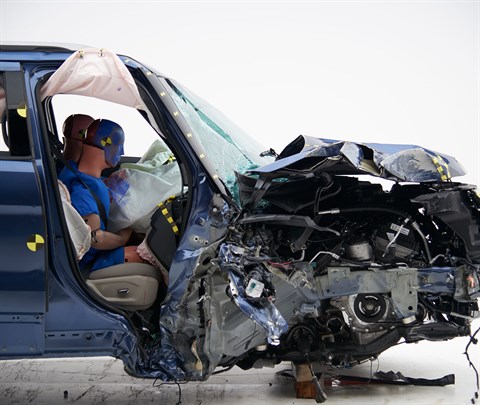
The dummy's position in relation to the door frame and dashboard after the crash test indicates that the passenger's survival space was not maintained well.
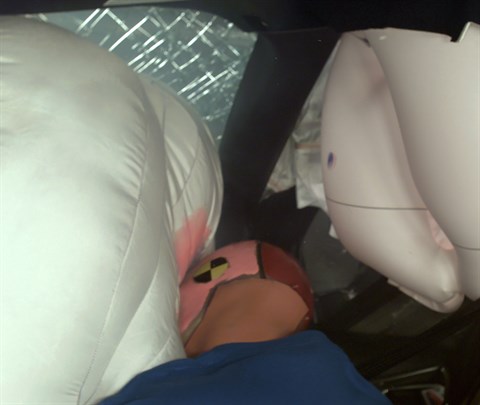
The dummy's head contacted the frontal airbag but then rolled around to the right.

Extensive intrusion of the dashboard and door hinge pillar contributed to a likely risk of injury to the right hip and a possible risk to the left lower leg.
Moderate overlap front: original test
Rating applies to 2011-19 models
Tested vehicle: 2011 Ford Explorer XLT 4-door 4wd
The Ford Explorer was redesigned for the 2011 model year and now shares the same basic design as the Ford Flex. Frontal ratings are assigned by the Institute based on a test conducted by Ford.
| Evaluation criteria | Rating |
|---|---|
| Overall evaluation | |
| Structure and safety cage | |
| Driver injury measures | |
| Head/neck | |
| Chest | |
| Leg/foot, left | |
| Leg/foot, right | |
| Driver restraints and dummy kinematics | |
Side: original test
Rating applies to 2016-19 models
Tested vehicle: 2016 Ford Explorer 4-door 4wd
The Ford Explorer was redesigned for the 2011 model year. Beginning with 2016 models, the front seat structure, front seat-mounted side torso airbags, and front and rear door trim were modified to improve occupant protection in side impact crashes. Side ratings are assigned by the Institute based on a test conducted by Ford.
Because there were no changes to the vehicle's body structure since 2011, the structure rating is based on both this test and an earlier test of a 2011 model Explorer conducted by Ford under the test verification procedure.
| Evaluation criteria | Rating |
|---|---|
| Overall evaluation | |
| Structure and safety cage | |
| Driver injury measures | |
| Head/neck | |
| Torso | |
| Pelvis/leg | |
| Driver head protection | |
| Rear passenger injury measures | |
| Head/neck | |
| Torso | |
| Pelvis/leg | |
| Rear passenger head protection | |
Roof strength
Rating applies to 2011-19 models
Tested vehicle: 2011 Ford Explorer XLT 4-door 4wd
| Overall evaluation | |
|---|---|
| Curb weight | 4,661 lbs |
| Peak force | 21,347 lbs |
| Strength-to-weight ratio | 4.58 |
Head restraints & seats
Seat type: Power leather seat
| Overall evaluation | |
|---|---|
| Dynamic rating | |
| Seat/head restraint geometry |
About the head restraint & seat test
Currently, IIHS tests apply only to front seats.
Headlights
Ratings are given for 2 different headlight variations available on this vehicle.
Trim level(s)
- XLT trim equipped with Ford Safe and Smart package
- Limited trim equipped with Ford Safe and Smart package
- Sport trim equipped with Ford Safe and Smart package
- Platinum trim
| Evaluation criteria | Rating |
|---|---|
| Low-beam headlight type | LED reflector |
| High-beam headlight type | Halogen reflector |
| Curve-adaptive? | No |
| High-beam assist? | Yes |
|
Overall rating | |
| Distance at which headlights provide at least 5 lux illumination: | |
Low beams
On the straightaway, visibility was good on both sides of the road. On curves, visibility was fair on the sharp left and both right curves and inadequate on the gradual left curve.
The low beams created excessive glare.
High beams
On the straightaway, visibility was fair on the right side of the road and inadequate on the left side. On curves, visibility was fair on both right curves and inadequate on both left curves.
High-beam assist compensates for some limitations of this vehicle's low beams on both left curves and on both right curves.
Trim level(s)
- Base trim
- XLT trim
- Limited trim
- Sport trim
| Evaluation criteria | Rating |
|---|---|
| Low-beam headlight type | LED reflector |
| High-beam headlight type | Halogen reflector |
| Curve-adaptive? | No |
| High-beam assist? | No |
|
Overall rating | |
| Distance at which headlights provide at least 5 lux illumination: | |
Low beams
On the straightaway, visibility was good on both sides of the road. On curves, visibility was fair on the sharp left and both right curves and inadequate on the gradual left curve.
The low beams created excessive glare.
High beams
On the straightaway, visibility was fair on the right side of the road and inadequate on the left side. On curves, visibility was fair on both right curves and inadequate on both left curves.
Front crash prevention: vehicle-to-vehicle
Child seat anchors
Rating applies to 2015-19 models
| Evaluation criteria | Rating |
|---|---|
| Overall evaluation | |
| Vehicle trim | XLT |
| Seat type | cloth |
This vehicle has 3 rear seating positions with complete child seat attachment (LATCH) hardware.
It has 1 additional seating position with a tether anchor and the ability to borrow lower anchors from the other seating positions.
Note: When anchors are borrowed, they aren't available to use in their designated positions.
| Evaluation criteria | Rating |
|---|---|
| Overall evaluation | |
| Vehicle trim | XLT |
| Seat type | cloth |
| Rating icon | Rating |
|---|---|
| G | Good |
| A | Acceptable |
| M | Marginal |
| P | Poor |
| Seating positions that rely on borrowed lower anchors or have only a tether anchor available are not rated. | |
thether anchor symbol | Tether anchor |
lower anchor symbol | Lower anchors |
| Lower anchor(s) can be borrowed from adjacent positions(s) | |
| No hardware available |
Details by seating position
| Position | Rating |
|---|---|
| 1 | |
| Tether anchor | |
| hard-to-find location | |
| no other hardware could be confused for anchor | |
| Lower anchors | |
| too deep in seat | |
| not too much force needed to attach | |
| easy to maneuver around anchors | |
| 2 | |
| Tether anchor | |
| hard-to-find location | |
| no other hardware could be confused for anchor | |
| Lower anchors | |
| Can be borrowed from 1 and 3 | |
| 3 | |
| Tether anchor | |
| hard-to-find location | |
| no other hardware could be confused for anchor | |
| Lower anchors | |
| too deep in seat | |
| not too much force needed to attach | |
| easy to maneuver around anchors | |
| 4 | |
| Tether anchor | |
| hard-to-find location | |
| other hardware could be confused for anchor | |
| Lower anchors | |
| not too deep in seat | |
| not too much force needed to attach | |
| easy to maneuver around anchors |
